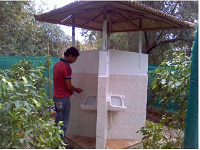Conservation - Reducing Water Usage
A resource book on waterless urinals, an ecological sanitation method that saves water, energy and uses urine as a resource
Posted on 02 Feb, 2013 05:40 PM
Waterless urinals (WLU) save water, energy and use urine as resource ( Image courtesy: R Sakthivel)
Everyone can conserve water at home: Follow the example of Anita, an IWP volunteer in Mumbai
Posted on 30 Jan, 2013 03:37 PMWater, as we all know is going to be the next biggest problem. With climate change already looming large, we have to consciously prepare for the future. On an individual level we can do our bit to contribute towards water conservation.
I, as a homemaker have implemented a few practices at home.
Battle for water: A video on the daily struggle of rural India for water
Posted on 22 Jan, 2013 08:47 PM
Water: Towards a paradigm shift in the Twelfth Plan - A paper by Mihir Shah in the EPW
Posted on 22 Jan, 2013 10:37 AMA fundamental change in the principles, approach and strategies of water management in India has been proposed in the Twelfth Plan
Why is this paradigm shift needed ?
"Launch research initiative to mainstream groundwater into urban water supply" - Arghyam’s inputs to the 2013-14 pre-budget consultation of the Finance Minister with social sector groups
Posted on 21 Jan, 2013 05:54 PMThese were the inputs given by Rohini Nilekani, Chairperson, Arghyam, to the Finance Minister at the pre-budget consultation event that took place on 4th January, 2013.
Udupi in Karnataka, sets standard for water management - Roundup of the week’s news (January 14 -20, 2013)
Posted on 21 Jan, 2013 03:20 PMUdupi in Karnataka, sets standard for water management
Building a coalition for the defense and nurturance of biodiversity - Side-event by SADED at the United Nations Convention on Biological Diversity, CoP-XI, Hyderabad
Posted on 21 Jan, 2013 11:12 AMThis side event at the Convention on Biological Diversity, CoP-XI, Hyderabad on 16th October, 2012 was organized by South Asian Dialogues on Ecological Democracy (SADED) in collaboration with Collective for Self Learning on Biodiversity, Beyond Copenhagen, Center for Local Health Traditions, CECOEDECON, Harit Swaraaj, Kisan Swar
Moving from paddy and sugarcane to less water-intensive crops such as oilseeds, pulses and millets can help resolve the Cauvery water dispute
Posted on 14 Jan, 2013 12:10 AMWhat happens when two or more states are dependent on same water resource for agricultural purposes ? Do the states compete for the resource or are their needs sufficiently different from each other? What are the consequences of the competition for this precious resource?
This article sheds light on the dispute between Karnataka and Tamil Nadu, for sharing Cauvery river water. The ongoing tussle between the two states has seen a lot of unrest amongst farmers in form of dharnas, protests, rail roko and non-cooperation by citizens, and disagreement with the agreements made by their respective governments and unending negotiations by governments involved, to come to a mutually agreeable decision.





